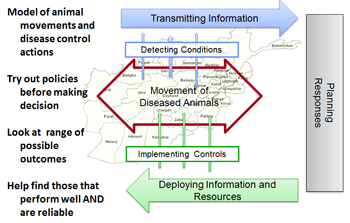
Modeling animal movement to help control disease

This agent-based epidemiological model of animal disease propagation was created to address problems within the beef and dairy industries in the US southwest. A consortium including the New Mexico State University (NMSU) Extension Service, the New Mexico Livestock Board (NMLB), ranchers representing the beef industry, and farmers representing the dairy industry suported model delvelopment, providing a thorough understanding of the life cycles for commodity livestock, especially the transportation and mixing of present commercial production. The model allows us to better understand how inter-operation transfer of livestock can impact the likelihood, magnitude, and geographic dispersal of infectious disease outbreaks, and aid in the assessment of the cost-effectiveness of current and proposed prevention, monitoring and mitigation strategies.
This model was extended to support design of disease control processes for migrating herds of goats and sheep in the Middle East where intervention resources are scarce, unevenly distributed and hard to deploy/apply. Computer simulation enables testing of policies to identify those that will perform well over a very large range of uncertainties (weather, availability of resources, novel pathogens, etc.).
Report
Development of an Agent-Based Epidemiological Model of Beef Cattle, July 2011 [PDF]
Presentations
Modeling Animal Movement to Help Control PPR: Update and Information Needs, June 2013 [PDF]
Modeling for Disease Control Policy, 2013 [PDF]